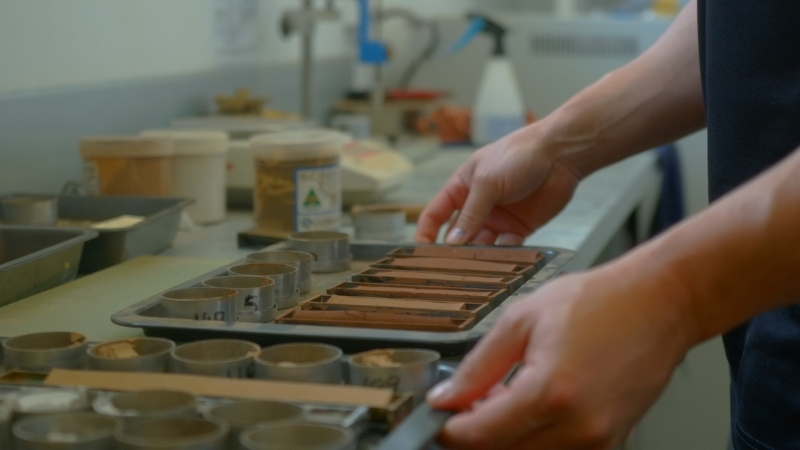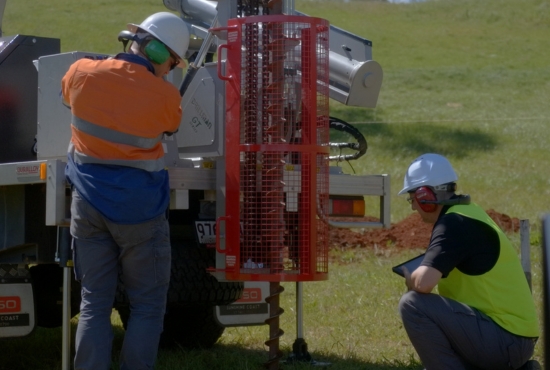


The outcomes presented in a geotechnical report help inform the design and construction of the proposed project by providing crucial information on ground conditions, such as its strength, capability, contamination, groundwater conditions and more, and expose potential complications with the selected site. By obtaining a geotechnical report early on in the construction process, the project team can avoid costly delays, budget blowouts and safety hazards all while maintaining compliance with relevant building regulations.
Geotechnical testing is completed either on-site (in situ) or back in our NATA-endorsed laboratory here in Toowoomba.
A particle size analysis is a test that is designed to assess the distribution of coarse soil taken from a selected site by passing a sample of the material through a series of progressively narrower mesh sieves and weighing the amount of material that is stopped at each level as a fraction of the whole mass.
Fine soil, on the other hand, is tested using the hydrometer method. This method calculates the size of the soil particles by the rate at which they settle out of suspension from a liquid. Large particles settle more quickly than the smaller particles which settle more slowly.
Most of the time both methods are carried out because typically, soil contains a combination of both coarse and fine grains.
Once we’ve completed these tests, we determine a ‘grade’ for the sample and depict it on a graph, and this is considered representative of the material as a whole. Soil gradation is a necessary tool to help determine the shear strength, compressive strength and the hydraulic conductivity of the material being investigated.
In Australia, sieve analysis is measured in accordance with AS1289.3.6.1 “Methods of testing soils for engineering purposes”.
One of the most important things we test for is ‘soil reactivity’. Soil that has been significantly impacted by a change in moisture level is called reactive soil. When there’s a greater probability that that soil will shift significantly due to the effects of moisture, it will have a higher ‘instability index’ which correlates to site surface movement classifications in accordance with AS2870 – “Residential Slab & Footings Classification”. When a soil is rated as highly reactive, there’s a high likelihood of it impacting your structural foundations.
Geotechnical drillers drill down into the ground and extract soil samples. Back in the laboratory, the geotechnical engineer will use the soil sample to prepare a ‘shrink’ sample and a ‘swell’ sample. The ‘shrink’ sample is weighed and measured carefully, pierced with push pins at either end and then placed out in open air to dry naturally until it stops shrinking. Measurements are recorded at timed intervals. The ‘swell’ sample is loaded into a weight bearing machine and submerged into water to see how much it
expands, and how it handles under pressure.
The California Bearing Ratio (CBR) test is used to measure the strength and load-bearing capacity of subsurface soil and base courses for road and highway pavements.
In order to conduct this test, our geotechnical team uses the CBR machine in our NATA-endorsed laboratory to penetrate a prepared sample and measure its resistance.
The CBR penetration test is conducted in a CBR machine, which is made up of a fixed, dual-column load frame that has an adjustable upper crossbeam and a lower plate that is checked at a pace rate of 1 mm per minute in vertical travel.
Laboratory samples are compacted into CBR moulds, submerged in water and loaded up with appendage weights prior to the test. The water is designed to replicate adverse moisture conditions from potential rainfall or flooding and the weights are designed to replicate the loads that will be built and carried on top of the soil and base courses.
A piston attached to a load cell penetrates the specimen and produces a load reading.
In Australia the governing standard for CBR tests is AS 1289.6.1.1 “Methods of testing soils for engineering purposes – Soil strength and consolidation tests, Method 6.1.1: Determination of the California Bearing Ratio of a soil – Standard laboratory method for a remoulded specimen”.
Soil compaction tests are typically conducted using a nuclear density moisture gauge.
Nuclear density moisture gauges are testing devices that use nuclear radiation to measure the density and moisture content of compacted material. These gauges are typically used during the construction phase of projects during bulk earthworks, service trench backfilling and during the construction of roads and highways.
Test data is obtained using two separate radiation sources within the gauge itself, these include:
Photons emitted from the source penetrate the test material and are scattered back to the base of the gauge to give a final reading. In the density range of interest, the number of photons detected is inversely proportional to the material density.
In Australia, the common methods used for density testing of soils using Nuclear Gauge are:
The Standard Penetration Test (SPT) is a procedure that’s designed to determine the ground properties at the base of an on-site borehole. To conduct the test, a Geotechnical Driller bores down to the intended sampling depth with a cylindrical sampling tube and then drives it into the ground with repeated blows from a specialised hammer. The test measures how many blows are needed for the sampling tube to reach certain depth intervals. Once the results have been determined, the information is used by the geotechnical team to determine the profile of the soil.
The SPT is conducted and measured in accordance with the Australian Standard AS 1289.6.3.1. “Methods of testing soils for engineering purposes”.
The Cone Penetration Test (CPT) is an alternative method of determining ground properties at a selected site. This method is conducted by driving a purpose-built cone vertically into the ground at a constant rate of penetration, building a continuous profile of the soil and other material below. During the test, various measurements are made of components such as resistance, friction and water pressure.
In Australia, the CPT is measured in accordance with the Australian Standard AS 1289.6.3.2 “Methods of testing soils for engineering purposes Soil strength and consolidation tests – Determination of the penetration resistance of a soil – 9 kg dynamic cone penetrometer test”.
These are just a few of the key geotechnical tests that form part of a geotechnical report. It’s important that when preparing for a proposed construction project, you work closely with a qualified team to ensure that your selected site is suitable. The team here at RMA Soils + Geotechnical are highly experienced in preparing, conducting and reporting the geotechnical components.
If you’d like to work with a team that produces accurate results and reliable recommendations, you can reach out to us at enquiries@rmasoils.com.au
